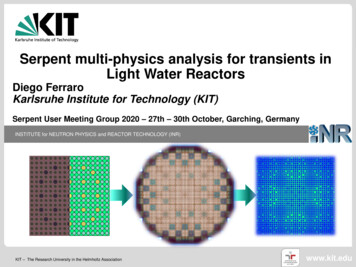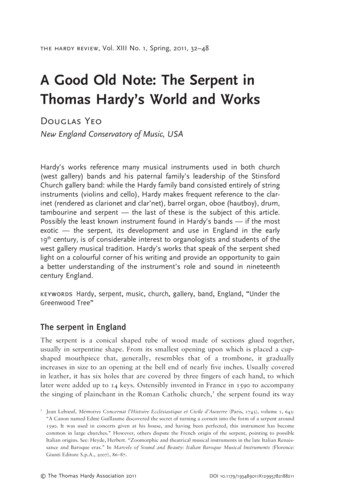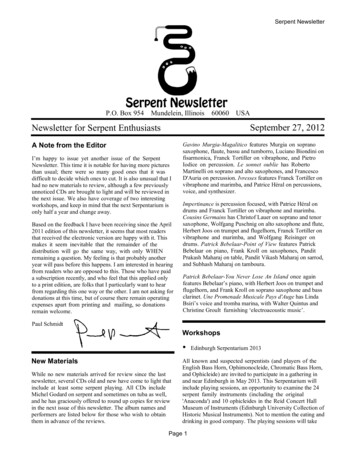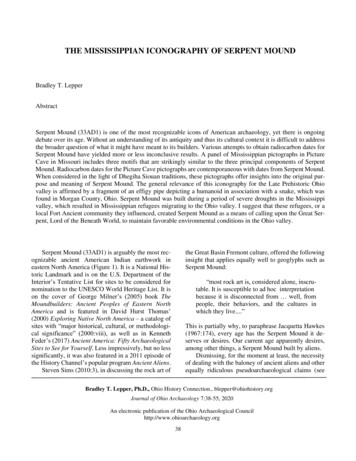
Transcription
Serpent multi-physics analysis for transients inLight Water ReactorsDiego FerraroKarlsruhe Institute for Technology (KIT)Serpent User Meeting Group 2020 – 27th – 30th October, Garching, GermanyINSTITUTE for NEUTRON PHYSICS and REACTOR TECHNOLOGY (INR)KIT – The Research University in the Helmholtz Associationwww.kit.edu
Outline1. Introduction2. The MC-based approach for coupledtransients3. Developed Serpent SCF (master-slave)coupling4. Verification and validation examples: Full-core Steady-state Comparison with experimental resultsfrom SPERT-IIIE Full scope PWR RIA-kind case5. Conclusions2SUMG 2020Introduction MC-based approach The toolVerification & ValidationConclusionsRPD-INR
1.1 IntroductionThe state of the art for reactor core calculations The reactor core is a complex(multidisciplinary) problem. From the wide span of designs, only LWR arehere discussed. Diverse time scopes are usually considered(i.e steady-state, burnup, transients). The two-step (cell-core) approach remains asthe industry-standard. This approach has inherent limitations. During recent years a worldwide trend todevelop high-fidelity approaches is observed. Objective: lower number of approximations,direct calculation of relevant parameters.Can we use MC-based neutronic codes plus subchannelTH to develop coupled transient calculations?3SUMG 2020Introduction MC-based approach The toolVerification & ValidationConclusionsRPD-INR
1.2 IntroductionThe high-fidelity proposal Replace the two-step approach by a direct pin-by-pin (MC-based) coupledcalculation.Potential advantages : Avoid the cell-core approach & reconstruction methods,direct safety-related calculations, fully alternative path.Potential drawbacks : Complexity, inherent limitations, calculation times.4SUMG 2020Introduction MC-based approach The toolVerification & ValidationConclusionsRPD-INR
2.1 The MC-based approachSerpent SCF MC-based Neutronics: Serpent 21. Take advantage of multiphysicscapabilities (IFC).2. Serpent transient calculationswithin reactors: Fixed source approach Known energy and distance oflive neutrons time is known Precursors are also modelledas waiting in interaction nsientsimulations5SUMG 2020IntroductionMC-based approach The tool Subchannel TH: SUBCHANFLOW Solve conduction convection at pinlevel (for a vapor liquid mix) For coolant: balance of mass, energyand lateral plus lateral momentum Steady state transientsVerification & ValidationConclusionsRPD-INR
3.1 Developed toolBasics of the internally coupled S-SCF tool How can we develop a coupled tool? What should we avoid? Master-slave (internal) approach is selected using a “new-philosophy” maintainability user friendly Serpent-SCF developed from scratch to tackle both steady-state, burnupand transient calculations Proven to be suitable for realistic coupled transient calculations [1]. Codes are kept wellseparated. Ad-hoccoupled routines. Use top levelroutines in Serpentand SCF (as library). Combined in a singleexecutable.[1] D. Ferraro et al. “Serpent/SUBCHANFLOW pin-by-pin coupled transient calculations for a PWR minicore”Annals of Nuclear Energy, 137:107090, 2020.6SUMG 2020IntroductionMC-based approach The tool Verification & ValidationConclusionsRPD-INR
3.2 Developed toolCoupled transients modelling in Serpent-SCFThe two-steps approach for the transient coupled case:dynsource(precursors andlive neutrons)Serpent SCFCoupled runSteady statecalculation(criticalitysource)Serpent SCFCoupled runTransientcalculation(fixed source)Converged powerdistribution fromIFCFirst run: initial conditionof the transient (critical)Second run: transient[1] D. Ferraro et al. “Serpent/SUBCHANFLOW pin-by-pin coupled transient calculations for a PWR minicore”Annals of Nuclear Energy, 137:107090, 2020.7SUMG 2020IntroductionMC-based approach The tool Verification & ValidationConclusionsRPD-INR
4. Verification & ValidationValidation of the Serpent/SCF approach for transients Validation of the tool represents a key issue. The approach followed was: Testing Verification Validation. Both steady-state, burnup and transient calculations should beassessed. Summary of capabilities are to be discussed. Scope: RIA-kind (Reactivity insertion accident) f.e. Rod Ejection. Several publications available, for diverse LWR geometries using pinby-pin coupling.Verification for RIAkind scenarios (fullscope PWR)Steady-state for full-corePWR casesValidation for RIA-kindscenarios (experimental data)8SUMG 2020IntroductionMC-based approach The toolVerification & ValidationConclusionsRPD-INR
4.1 Verification & ValidationSteady-state for LWR cases (1) PWR numerical MOX/UO2 benchmark at HFP (Hot Full Power) [2] - Pinby pin coupled analysis in square geometry for steady-state:Pin-wise power distribution atmid active lengthTemperature distribution atmid active length Consistent behavior Differences with reported results 30 ppm Boron. Pin-power distribution differences 2%.[2] D. Ferraro et al. “OECD/NRC PWR MOX/UO2 core transient benchmark pin-by-pin solutionsusing Serpent/SUBCHANFLOW” –Annals of Nuclear Energy 147:107745,2020.9SUMG 2020IntroductionMC-based approach The toolVerification & ValidationSteady-state (PWR)ConclusionsRPD-INR
4.1 Verification & ValidationSteady-state for LWR cases (2) VVER experimental benchmark (Hot Full Power) - Pin by pin coupledanalysis in hexagonal geometry for steady-state [3]:Pin-wise power distribution atmid active lengthTemperature distribution atmid active length Consistent behavior Diff. with reported results (critical): 300 pcm at 1500 MWth.[3] Diego Ferraro et al " Serpent / SUBCHANFLOW coupled calculations for a VVER core at hot fullpower. In PHYSOR202010SUMG 2020IntroductionMC-based approach The toolVerification & ValidationSteady-state (VVER)ConclusionsRPD-INR
4.2 Validation for transientsThe SPERT-IIIE experiments USA 1950s-1960s safety program. Devoted to RIA transients investigation(several configurations and reactors). Fuel Rodded type, SS cladding. Squarelattice array, 3 types of FA : standard,central and Control (fuel follower with CR). Operation at pressure and temperaturesimilar to PWR. Transient experiments done throughwithdrawal of central CR.11SUMG 2020IntroductionMC-based approach The toolVerification & ValidationConclusionsTransients in SPERT-IIIERPD-INR
4.2 Validation for transients SPERT-IIIE modelling approachPin-by-pin models developed and validated for cold and HFP states [4]Steady-state and transient calculationsSeveral modeling decisionsTwo transients were selected: T-84 and T-85Serpent modelSCF model[4] D. Ferraro et al. " Serpent/SUBCHANFLOW pin-by-pin coupled transient calculations for SPERT-IIIEhot full power test " – Annals of Nuclear Energy - Volume 142 (2020).12SUMG 2020IntroductionMC-based approach The toolVerification & ValidationConclusionsTransients in SPERT-IIIERPD-INR
4.2 Validation for transientsSPERT-IIIE: Global results for T-84 and T-85 Results for coupled transient Serpent-SCF (global):ModeledSpeed [cm/s]Time scope of movement [s]-67.10.04-0.17-163.50.02-0.16CR withdrawal .20.100 130.8Measured power [MW]S-SCF Power [MW]Measured Rho [ ]Rho S-SCF (imp) [ ]0.10.20.30.40.5 0.6Time [s]0.70.80.91Power [MW]1Reactivity [ ]Power ed power [MW]S-SCF Power [MW]Measured Rho [ ]Rho S-SCF (imp) [ ]00.10.20.30.40.5 0.6Time [s]0.70.80.9Reactivity [ ]ID1Very good agreement both for power and reactivity.SUMG 2020IntroductionMC-based approach The toolVerification & ValidationConclusionsTransients in SPERT-IIIERPD-INR
4.2 Validation for transientsSPERT-IIIE: High-fidelity results for T-85 Results for coupled transient Serpent-SCF for test T-85 (pin-by-pin):Power evolution (up to 0.2 s):Temperature evolution(up to 0.2 s): 10h CPU @ 2.6GHz for each run(in 1000 cpus) SCF calculationtime negligible14SUMG 2020IntroductionMC-based approach The toolVerification & ValidationConclusionsTransients in SPERT-IIIERPD-INR
4.3 Validation for transientsFull scope RIA-kind in a realistic PWR Full-core pin-by-pin realistic applications? The OECD PWR MOX/UO2 transient benchmark was developed(Kozlowski & Downar).¼ Core15SUMG 2020IntroductionFuel detailsMC-based approach The toolVerification & ValidationConclusionsPWR MOX transientsRPD-INR
4.3 Validation for transientsModels for the OECD PWR MOX/UO2 transient benchmark Models for Serpent-SCF were developed for Parts I to IV of benchmark(2D HZP, 3D HFP, 3D HZP, 3D HZP RIA) [2]. Diverse key parameters compared with reported results (referencevalues also provided within the Benchmark).SCF model Pin-by-pin coupling.[2] D. Ferraro et al. “OECD/NRC PWR MOX/UO2 core transient benchmark pin-by-pin solutions usingSerpent/SUBCHANFLOW” –Annals of Nuclear Energy 147:107745,2020.16SUMG 2020IntroductionMC-based approach The toolVerification & ValidationConclusionsPWR MOX transientsRPD-INR
4.3 Validation for transientsModels for the OECD PWR MOX/UO2 transient benchmark Models for Serpent-SCF were developed for Parts I to IV of benchmark(2D HZP, 3D HFP, 3D HZP, 3D HZP RIA) [6]. Diverse key parameters compared with reported results (referencevalues also provided within the Benchmark).Serpent model Pin-by-pin coupling.CR sudden extraction (0.1s).[2] D. Ferraro et al. “OECD/NRC PWR MOX/UO2 core transient benchmark pin-by-pin solutions usingSerpent/SUBCHANFLOW” –Annals of Nuclear Energy 147:107745,2020.17SUMG 2020IntroductionMC-based approach The toolVerification & ValidationConclusionsPWR MOX transientsRPD-INR
4.3 Validation for transientsMain results for the OECD PWR MOX/UO2 transient benchmark Results for transient (RIA case) from HZP.CodePeak time [s]EPISODE0.33PARCS 2G0.34PARCS 8G0.32Serpent-SCF0.355Peak Power [%]160142172179 26Peak [ ]1.131.121.141.18 0.02Integral power [%s]26.927.229.127.7 120 h in 1280 processors / SCF calculation time not negligible!18SUMG 2020IntroductionMC-based approach The toolVerification & ValidationConclusionsPWR MOX transientsRPD-INR
4.3 Validation for transientsMain results for the OECD PWR MOX/UO2 transient benchmark Detailed results for power – time 0.2 s19SUMG 2020IntroductionMC-based approach The toolVerification & ValidationConclusionsPWR MOX transientsRPD-INR
4.3 Validation for transientsMain results for the OECD PWR MOX/UO2 transient benchmark Detailed results for power – time 0.25 s20SUMG 2020IntroductionMC-based approach The toolVerification & ValidationConclusionsPWR MOX transientsRPD-INR
4.3 Validation for transientsMain results for the OECD PWR MOX/UO2 transient benchmark Detailed results for power – time 0.27 s21SUMG 2020IntroductionMC-based approach The toolVerification & ValidationConclusionsPWR MOX transientsRPD-INR
4.3 Validation for transientsMain results for the OECD PWR MOX/UO2 transient benchmark Detailed results for power – time 0.34 s22SUMG 2020IntroductionMC-based approach The toolVerification & ValidationConclusionsPWR MOX transientsRPD-INR
4.3 Validation for transientsMain results for the OECD PWR MOX/UO2 transient benchmark Detailed results for power – time 0.4 s23SUMG 2020IntroductionMC-based approach The toolVerification & ValidationConclusionsPWR MOX transientsRPD-INR
4.3 Validation for transientsMain results for the OECD PWR MOX/UO2 transient benchmark Detailed results for power – time 0.55 s24SUMG 2020IntroductionMC-based approach The toolVerification & ValidationConclusionsPWR MOX transientsRPD-INR
4.3 Validation for transientsMain results for the OECD PWR MOX/UO2 transient benchmark Detailed results for temperature – time 0.55 s Direct pin-bypin results. Consistentbehavior.25SUMG 2020IntroductionMC-based approach The toolVerification & ValidationConclusionsPWR MOX transientsRPD-INR
5. Conclusions Alternative approach to industry-standard most of cell-coreapproximations avoided. Serpent-SCF new internal coupling was tested verified validated within realistic conditions. First validation of coupled transient capabilities successfullyheld using SPERT-IIIE. Full-scope within PWR geometries verified with MOX/UO2transient benchmark. Main coupled physics behaved as expected for all cases. Good agreement with reported experimental data / othercodes. Serpent-SCF approach for coupled transients is provento be feasible. Results pave the path for industry-like applications.26SUMG 2020IntroductionMC-based approach The toolVerification & ValidationConclusionsRPD-INR
Further questions?Thanks!27RPD-INR
Serpent-SCF developed from scratch to tackle both steady-state, burnup and transient calculations Proven to be suitable for realistic coupled transient calculations [1]. Codes are kept well separated. Ad-hoc coupled routines. Use top level routines in Serpent










